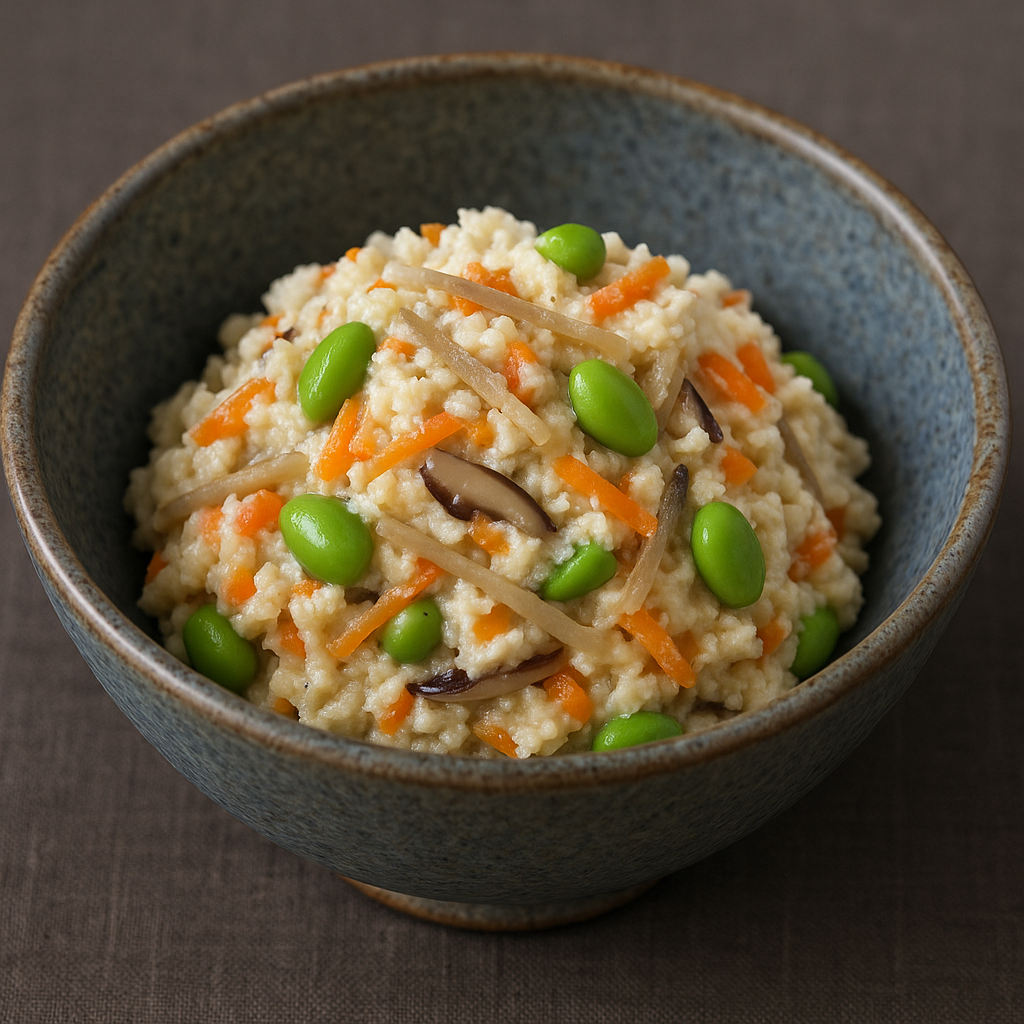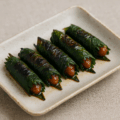きしゃず炒り(宮城)の特徴
“きしゃず(おから)”を野菜と炒り合わせる、滋味ゆたかな常備菜です
きしゃず炒りは、豆腐づくりで生まれるおから(宮城では「きしゃず」とも呼びます)を、根菜やきのこ、油揚げなどと炒り煮にして仕上げる郷土料理です。ほろほろとした口当たりに、しょうゆとだしの香りがやさしく広がります。
精進のおかずから“ごはんの友・お弁当の定番”へ
肉を使わない精進料理として親しまれてきましたが、地域や家庭によっては鶏ひき肉やツナを少量加えて旨みを補う作り方も受け継がれています。作り置きがしやすく、冷めてもおいしいのが魅力です。
きしゃず炒り(宮城) レシピ
材料(5人分)
- おから(生) … 300g
- にんじん … 80g(細切り)
- ごぼう … 60g(ささがき・水にさらす)
- 干し椎茸 … 3枚(戻して薄切り・戻し汁は調味に)
- ごま油 … 大さじ1
- だし … 120ml(椎茸の戻し汁を含める)
- 砂糖 … 大さじ1と1/2
- みりん … 大さじ1
- しょうゆ … 大さじ2と1/2
- 酒 … 大さじ1
- 塩 … 少々(味の締め)
- 白いりごま … 大さじ1(仕上げ)
作り方
- 具を切る。干し椎茸は戻して薄切り、戻し汁はこして取っておく。
- フライパンにごま油。(肉を使う場合は)ひき肉を炒め、色が変わったら取り出す。
- 同じ鍋でにんじん・ごぼう・椎茸を炒め、油を回す。
- おからを加えて弱めの中火。木べらでほぐしながら乾きが出るまで炒る。
- だし・砂糖・みりん・しょうゆ・酒を加え、混ぜながら水分を飛ばす。
- ぱらりとするまで炒りつける。
- 味を見て塩で微調整。火を止め、白いりごまを混ぜる。
シェフのワンポイントアドバイス
- おからは先に軽く乾煎りするとべたつかず、味が入りやすいです。
- 水分は少しずつ。ぱらり手前で火を止めると、冷めても固くなりにくいです。
栄養価(1人分の目安)
- エネルギー … 160〜240 kcal
- たんぱく質 … 8〜13 g(おから由来)
- 脂質 … 6〜11 g
- 炭水化物 … 12〜20 g
- 食物繊維 … 4〜7 g(おから・ごぼう由来)
歴史
“きしゃず=おから”の呼び名が残る、精進の惣菜です
豆腐づくりで生じるおからを無駄なく使う知恵から生まれ、宮城では「きしゃず」の名で呼ばれてきました。野菜とともに炒り煮にする作り方が定着しています。
行事と日常をつなぐ常備菜として受け継がれました
大鍋で作って配る場面や、弁当のおかずとして重宝され、家庭ごとの具材や味付けが“我が家の味”として今も伝わっています。
English Version
Features of Kishazu Iri (Okara Stir-Fry) (Miyagi)
Gently seasoned okara, dry-stirred with vegetables
Kishazu iri is a local stir-fry that uses okara—the soy pulp left from tofu making, called “kishazu” in parts of Miyagi—cooked with root vegetables, mushrooms, and aburaage or other add-ins. The fluffy, crumbly texture carries soy sauce and dashi aromas for a comforting finish.
From temple fare to a bento-box regular
Rooted in Buddhist vegetarian cooking, the dish remains flexible: some households add a small amount of ground chicken or canned tuna to boost umami. It keeps well and tastes good even when cool, making it a staple side for rice and lunchboxes.
Recipe – Kishazu Iri (Okara Stir-Fry) (Miyagi)
Ingredients (Serves 5)
- Fresh okara (soy pulp) … 300 g
- Carrot … 80 g, cut into fine matchsticks
- Burdock root (gobo) … 60 g, shaved (sasagaki), briefly soaked
- Dried shiitake … 3 caps, rehydrated and thinly sliced (reserve soaking liquid)
- Sesame oil … 1 tbsp
- Dashi … 120 ml (include the shiitake soaking liquid)
- Sugar … 1½ tbsp
- Mirin … 1 tbsp
- Soy sauce … 2½ tbsp
- Sake … 1 tbsp
- Salt … a pinch (to finish)
- Toasted white sesame seeds … 1 tbsp (to finish)
- [Optional] Ground chicken or canned tuna … a small amount
Directions
- Prep vegetables: rehydrate shiitake and strain the soaking liquid; slice shiitake. Cut carrot into fine matchsticks. Shave burdock (sasagaki) and soak briefly; drain well.
- Heat sesame oil in a large skillet. If using meat, sauté until the color changes; remove and set aside.
- In the same pan, sauté carrot, burdock, and shiitake until coated with oil and lightly fragrant.
- Add okara. Cook over medium-low heat, breaking it up with a spatula, until lightly dried and fluffy.
- Return meat (if using). Add dashi, sugar, mirin, soy sauce, and sake. Stir and cook, letting the moisture evaporate.
- Stir-fry until the mixture turns crumbly and almost dry.
- Taste and fine-tune with a pinch of salt. Turn off the heat and fold in toasted white sesame seeds.
Chef’s Tips
- Briefly dry-toast the okara first to prevent stickiness and help seasonings penetrate.
- Add liquids gradually and stop the heat just before fully dry so the texture stays tender after cooling.
Nutrition (per serving, approx.)
- Energy … 160–240 kcal
- Protein … 8–13 g (mostly from okara)
- Fat … 6–11 g
- Carbohydrates … 12–20 g
- Dietary fiber … 4–7 g (okara, burdock)
History
Name and origin
“Kishazu” is a regional name for okara, the nutrient-rich byproduct of tofu making. The dish arose from the wisdom of using every part of the soybean with minimal waste.
From temple kitchens to home tables
Initially valued as a meatless, frugal side, it spread through households, where some families now add a little chicken or tuna to deepen the umami while keeping the dish light.
Community and everyday life
Often cooked in large batches to share, it became a reliable make-ahead side. Seasoning and add-ins vary by home, forming each family’s characteristic taste.



何でも質問してください!